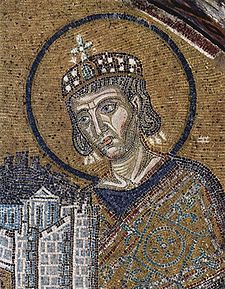
Back I Никеитәи Адунеизегьтәи Аизара ду Abkhazian Eerste Konsilie van Nicea Afrikaans Primer Concilio de Nicea AN مجمع نيقية الأول Arabic مجمع نيقيا الاول ARZ Conceyu de Nicea I AST Birinci Nikeya Kilsə Məclisi Azerbaijani Enot na Konsilyo kan Nicea BCL Першы Нікейскі сабор Byelorussian Першы Нікейскі сабор BE-X-OLD
The First Council of Nicaea was held in Nicaea, in Bithynia in 325. Nicea is the city of Iznik in Turkey. The Roman Emperor Constantine I called the bishops of the Roman Empire to the first ecumenical[1] conference of the early Christian Church. It had as most important result the first uniform Christian doctrine, called the Nicene Creed.
With the creation of the creed, a precedent was established for subsequent 'general (ecumenical) councils of Bishops' (Synods) to create statements of belief and church law. The purpose was to define unity of beliefs for the whole of Christendom.

- ↑ Ecumenical, from Koine Greek oikoumenikos, literally meaning worldwide but generally assumed to be limited to the Roman Empire as in Augustus' claim to be ruler of the oikoumene/world; the earliest extant uses of the term for a council are Eusebius' Life of Constantine 3.6 Eusebius. Vita Constantini - Greek around 338 "σύνοδον οἰκουμενικὴν συνεκρότει" (he called for an Ecumenical council), Athanasius' Ad Afros Epistola Synodica in 369 CHURCH FATHERS: Ad Afros Epistola Synodica (Athanasius), and the Letter in 382 to Pope Damasus I and the Latin bishops from the First Council of ConstantinopleNPNF2-14. The Seven Ecumenical Councils - Christian Classics Ethereal Library Archived 2009-10-29 at the Wayback Machine